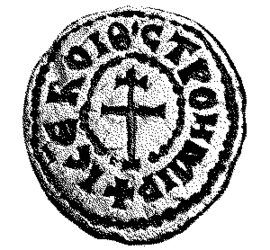Strojimir
Strojimir (Greek: Στροἠμιρ, Στροἠμηρος, Serbian Cyrillic: Стројимир) was the co-ruler of the Serbian Principality alongside his two brothers Mutimir and Gojnik, from ca 851 to his and Gojnik's deposition in the 880s after an unsuccessful coup against the eldest Prince Mutimir (r. 851-891).
| Strojimir | |||||
|---|---|---|---|---|---|
| Prince (archon) of Serbs / Serbia | |||||
 Seal | |||||
| Prince of Serbia (co-ruler) | |||||
| Reign | 851–880s | ||||
| Predecessor | Vlastimir | ||||
| Successor | Mutimir (sole) | ||||
| Died | between 880 and 896 | ||||
| |||||
| House | Vlastimirović | ||||
| Father | Vlastimir | ||||
| Religion | Eastern Orthodox | ||||
He was a younger son of Vlastimir, who ruled in c. 836–851. Strojimir, together with his brothers Gojnik and Mutimir, defeated the Bulgarian Army sent by Boris I, led by his son Vladimir, who, together with 12 boyars was captured by the Serb Army. Peace was subsequently agreed and the two sons of Mutimir; Pribislav and Stefan Mutimirović escorted prisoners towards the border at Rasa. There Boris gave them rich gifts and was given 2 slaves, 2 falcons, two dogs, and 80 furs by Mutimir.[1]
After power struggle between the younger brothers and Mutimir, he and Gojnik was captured and sent as prisoners to Bulgarian Khan Boris I in 855–856, as a token of peace-agreement, they both lost their titles as Princes of Serbia and were held at Pliska, the Bulgarian capital. Strojimir was treated well by the Bulgarians, Khan Boris himself chose the wife of Klonimir, the son of Strojimir.
The Seal of Strojimir
On July 11, 2006, the Serbian government bought a Byzantine-styled seal in solid gold weighing 15,64 g, most likely belonging to Strojimir (Klonimir's father), at an auction in Munich. It was presumably crafted outside Byzantium, and has a Greek inscription (KE BOIΘ CTPOHMIP, "God Help Strojimir") and a patriarchal cross in the centre. It most likely dates to the second half of the 9th century, between 855/56 and 896, when Klonimir tried to take the Serbian throne.[2][3]
References
- Moravcsik 1967, p. 155.
- Živković 2007, pp. 23–29.
- https://www.rastko.rs/rastko/delo/15599
Sources
- Moravcsik, Gyula, ed. (1967) [1949]. Constantine Porphyrogenitus: De Administrando Imperio (2nd revised ed.). Washington D.C.: Dumbarton Oaks Center for Byzantine Studies.CS1 maint: ref=harv (link)
- Ćirković, Sima (2004). The Serbs. Malden: Blackwell Publishing.CS1 maint: ref=harv (link)
- Curta, Florin (2006). Southeastern Europe in the Middle Ages, 500–1250. Cambridge: Cambridge University Press.CS1 maint: ref=harv (link)
- Ferjančić, B. (1997). "Василије I и обнова византијске власти у IX веку". Zbornik radova Vizantološkog instituta (36): 9–30.
- Fine, John Van Antwerp Jr. (1991) [1983]. The Early Medieval Balkans: A Critical Survey from the Sixth to the Late Twelfth Century. Ann Arbor, Michigan: University of Michigan Press.CS1 maint: ref=harv (link)
- Ostrogorsky, George (1956). History of the Byzantine State. Oxford: Basil Blackwell.CS1 maint: ref=harv (link)
- Petrović, R. (2007). "Zlatni pečatni privezak kneževića Strojimira". Naučni projekt Filozofskog fakulteta u K. Mitrovici. 1.
- Runciman, Steven (1930). A History of the First Bulgarian Empire. London: G. Bell & Sons.CS1 maint: ref=harv (link)
- Vlasto, Alexis P. (1970). The Entry of the Slavs into Christendom: An Introduction to the Medieval History of the Slavs. Cambridge: Cambridge University Press.CS1 maint: ref=harv (link)
- Живковић, Тибор (2006). Портрети српских владара: IX-XII век (Portraits of Serbian Rulers: IX-XII Century). Београд: Завод за уџбенике и наставна средства.CS1 maint: ref=harv (link)
- Živković, Tibor (2007). "The Golden Seal of Stroimir" (PDF). Historical Review. Belgrade: The Institute for History. 55: 23–29.CS1 maint: ref=harv (link)
External links
- Steven Runciman, A History of the First Bulgarian Empire, London 1930.
- "Pečat srpskog kneza Strojimira".
Strojimir Born: 830s Died: 880-896 | ||
| Regnal titles | ||
|---|---|---|
| Preceded by Vlastimir |
Prince of Serbia 851-880s Served alongside: Mutimir and Gojnik |
Succeeded by Mutimir as sole ruler of Serbia |